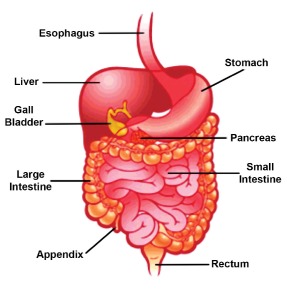In my first post I mentioned listing foods as ‘safe’, ‘tolerable’ and ‘intolerable’ based on how your gut reacts to them and gave you a list of generally safe foods and avoidable foods to give you something to start adding meals around.
The type of foods you are eating may not be the only problem to your digestive system but there are ways we can prevent and reduce any inflammation and upset.
Our bodies work like a machine and when it works well everything is in perfect harmony; input, process, output. Together, a combination of nerves, hormones, bacteria, blood, and the organs of the digestive system completes the complex task of digesting the foods and liquids a person consumes each day.
So with that in mind, let’s see what ‘equipment’ (our organs) we have to work with.

The image above is a typical one you will find for the digestive system but it is worth remembering the effects on your digestion happen before you even start eating.
To aid digestion and reduce the risk of any upsets make sure you are mentally ready to eat. If you are stressed or unhappy it is best to give yourself some time to unwind before having a meal. When ready sit upright, dining chairs are ideal, as this does not constrict your stomach activity. Now you are ready to eat…
The Mouth
Your mouth is the first indicator whether a food is okay to eat, along with your sense of smell, take gone off milk for an example. If you like the smell and taste of the contents then your saliva glands will produce the enzyme ptyalin (also known as amylase), this is used to breakdown carbohydrates, converting starchy food, like bread, into maltose; a sugar which can be absorbed immediately.
It is thought that less than 5% of all starches consumed are digested within the mouth, before being swallowed as most of the digestive changes occur later on. This is because starch is a type of complex carbohydrate, which means that it’s made of long chains of sugars called polysaccharides. Foods high in starch, such as potatoes and some other tubers and root vegetables, are not as easily digested as simpler carbohydrates such as fruit, baked goods and pasta.
Therefore to help with this process it is important to chew your food as much as you can, it is recommended up to 32 times, if possible. Chewing for longer means your meal will last longer, making you eat smaller portions, one reason for this could be the time taken for your brain to signal that the stomach is full. This usually takes around 20 minutes.
When large particles of improperly chewed food enter your stomach, it may remain undigested when it enters your intestines. There, bacteria will begin to break it down, or in other words it will start to putrefy, potentially leading to gas and bloating, diarrhoea, constipation, abdominal pain, cramping and other digestive problems.
To reduce these problems, take smaller bites and swallow what you have already chewed before taking another bite. To reduce the symptoms of wind and bloating, try not to take down air when drinking or swallowing food.
Look out for more updates about processes throughout the digestive system coming soon.

Pingback: The Digestive System: The Oesophagus – Find a Friend in Food
Pingback: The Digestive System: The Stomach – Find a Friend in Food